

Lauren Dickie
Macbeth. A poster for a c. 1884 American production of Macbeth, starring Thomas W.

Keene. Depicted, counterclockwise from top-left, are: Macbeth and Banquo meet the witches; just after the murder of Duncan; Banquo's ghost; Macbeth duels Macduff; and Macbeth. Macbeth (full title The Tragedy of Macbeth) is a tragedy written by William Shakespeare, and is considered one of his darkest and most powerful works. Set in Scotland, the play dramatizes the corrosive psychological and political effects produced when evil is chosen as a way to fulfill the ambition for power. The play is believed to have been written between 1599 and 1606, and is most commonly dated 1606. Characters[edit] Plot[edit] Three Witches. Scene from Macbeth, depicting the witches' conjuring of an apparition in Act IV, Scene I.
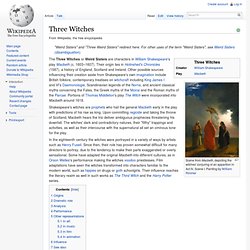
Painting by William Rimmer The Three Witches or Weird Sisters are characters in William Shakespeare's play Macbeth (c. 1603–1607). Their origin lies in Holinshed's Chronicles (1587), a history of England, Scotland and Ireland. Other possible sources influencing their creation aside from Shakespeare's own imagination include British folklore, contemporary treatises on witchcraft including King James I and VI's Daemonologie, Scandinavian legends of the Norns, and ancient classical myths concerning the Fates, the Greek myths of the Moirai and the Roman myths of the Parcae.
Macduff (Macbeth) The character is first known from Chronica Gentis Scotorum (late 14th century) and Orygynale Cronykil of Scotland (early 15th century).
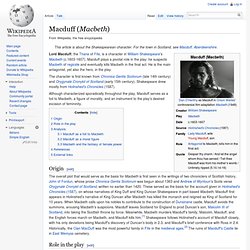
Shakespeare drew mostly from Holinshed's Chronicles (1587). Although characterized sporadically throughout the play, Macduff serves as a foil to Macbeth, a figure of morality, and an instrument to the play’s desired excision of femininity. The overall plot that would serve as the basis for Macbeth is first seen in the writings of two chroniclers of Scottish history, John of Fordun, whose prose Chronica Gentis Scotorum was begun about 1363 and Andrew of Wyntoun's Scots verse Orygynale Cronykil of Scotland, written no earlier than 1420. Macduff's son. Macduff's son is a character in William Shakespeare's tragedy Macbeth (1606).
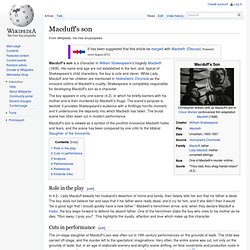
His name and age are not established in the text, and, typical of Shakespeare's child characters, the boy is cute and clever. While Lady Macduff and her children are mentioned in Holinshed's Chronicle as the innocent victims of Macbeth's cruelty, Shakespeare is completely responsible for developing Macduff's son as a character. The boy appears in only one scene (4.2), in which he briefly banters with his mother and is then murdered by Macbeth's thugs. The scene's purpose is twofold: it provides Shakespeare's audience with a thrillingly horrific moment, and it underscores the depravity into which Macbeth has fallen. The brutal scene has often been cut in modern performance. Lady Macduff. Origin[edit] Macduff and Lady Macduff appear in both Raphael Holinshed’s Chronicles (1577) and Hector Boece’s Scotorum Historiæ (1526).[1] Holinshed’s Chronicles was Shakespeare’s main source for Macbeth, though he diverged from the Chronicles significantly by delaying Macduff’s knowledge of his wife’s murder until his arrival in England.
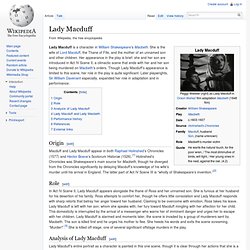
The latter part of Act IV Scene III is “wholly of Shakespeare’s invention.”[2] Role[edit] In Act IV Scene II, Lady Macduff appears alongside the thane of Ross and her unnamed son. She is furious at her husband for his desertion of his family. King Duncan. Analysis[edit] King Duncan is a father-figure who is generous but firm ("No more that Thane of Cawdor shall deceive / Our bosom interest.
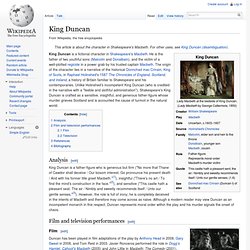
Go pronounce his present death / And with his former title greet Macbeth. "[1]), insightful ("There's no art / To find the mind's construction in the face. Film and television performances[edit] Film[edit] In Orson Welles' 1948 film adaptation of Macbeth, the role of King Duncan is reduced. 1.2 is cut entirely as well as generous portions of 1.4. Donalbain (Macbeth) He is based upon a personage in an account of King Duncan in Holinshed's Chronicles, a history of Britain familiar to Shakespeare.[1] He is ultimately based on the historical King Donald III of Scotland.
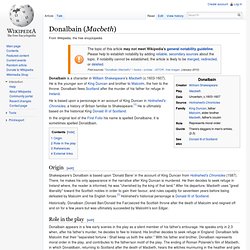
In the original text of the First Folio his name is spelled Donalbaine, it is sometimes spelled Donaldbain. Shakespeare's Donalbain is based upon 'Donald Bane' in the account of King Duncan from Holinshed's Chronicles (1587). There, he makes his only appearance in the narrative after King Duncan is murdered. He then decides to seek refuge in Ireland where, the reader is informed, he was "cherished by the king of that land. " After his departure, Macbeth uses "great liberality" toward the Scottish nobles in order to gain their favour, and rules capably for seventeen years before being defeated by Malcolm and his English forces.[1] Holinshed's historical personage is Donald III of Scotland. Banquo. Source[edit]
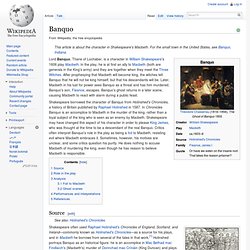
Fleance. Shakespeare's play is adapted from Holinshed's Chronicles, a history of the British Isles written during the late sixteenth century.
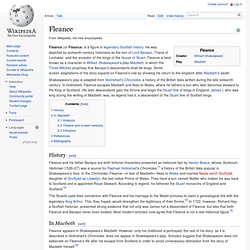
In Holinshed, Fleance escapes Macbeth and flees to Wales, where he fathers a son who later becomes steward to the King of Scotland. His later descendants gain the throne and begin the Stuart line of kings in England. James I, who was king during the writing of Macbeth, was, as legend had it, a descendant of the Stuart line of Scottish kings. History[edit] Fleance and his father Banquo are both fictional characters presented as historical fact by Hector Boece, whose Scotorum Historiae (1526–27) was a source for Raphael Holinshed's Chronicles,[1] a history of the British Isles popular in Shakespeare's time. The Stuarts used their connection with Fleance and his marriage to the Welsh princess to claim a genealogical link with the legendary King Arthur. Lady Macbeth. According to some genealogists, Lady Macbeth and King Duncan's wife were sisters or cousins, where Duncan's wife had a stronger claim to the throne than Lady Macbeth.
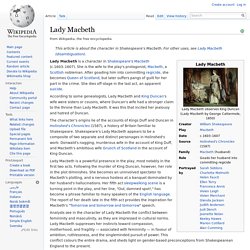
It was this that incited her jealousy and hatred of Duncan. The character's origins lie of the accounts of Kings Duff and Duncan in Holinshed's Chronicles (1587), a history of Britain familiar to Shakespeare. Shakespeare's Lady Macbeth appears to be a composite of two separate and distinct personages in Holinshed's work: Donwald's nagging, murderous wife in the account of King Duff, and Macbeth's ambitious wife Gruoch of Scotland in the account of King Duncan. Analysts see in the character of Lady Macbeth the conflict between femininity and masculinity, as they are impressed in cultural norms. Lady Macbeth suppresses her instincts toward compassion, motherhood, and fragility — associated with femininity — in favour of ambition, ruthlessness, and the singleminded pursuit of power.
Origins[edit] Macbeth. No Fear Shakespeare puts Shakespeare's language side-by-side with a facing-page translation into modern English—the kind of English people actually speak today. Table of Contents Characters Act 1 Act 1, Scene 1 Act 1, Scene 2 Act 1, Scene 3 Act 1, Scene 4 Act 1, Scene 5 Act 1, Scene 6 Act 1, Scene 7 Act 2. Macbeth Supernatural Elements. These analytical papers are designed to review your knowledge of the drama and apply that knowledge to a critical paper. The topics may request that you examine the conflicts, themes, or question a standard theory about the play. Topic #1 The term tragic hero refers to a central character who has a authoritative status in the drama, but through a flaw in his or her character brings about his or her demise. The flaw may consist of a poor decision that is made and creates a situation the character cannot change or control. The tragic hero recognizes his or her flaw, however there is nothing that can be done to avert tragedy.
Macbeth is seen as a tragic hero. Outline I. II. III. IV. V. VI. VII. VIII. IX. Macbeth: List of Scenes.